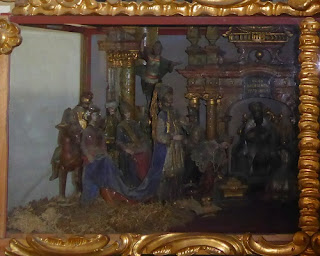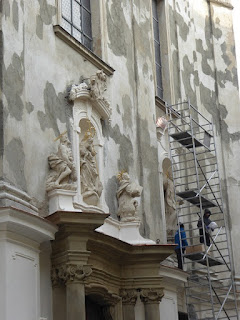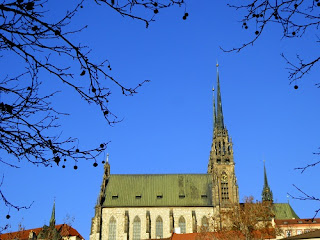Thursday, 27 December 2018
Berlioz's tender masterpiece
The more I hear L'enfance du Christ, the more I love it. So I'm glad to have taken the chance of the BBC Symphony Orchestra's latest performance - the previous one, six years ago, was also miraculous - to hold a class on the afternoon of the concert. One thinks of Berlioz as a lopsided master in the larger-scale works - or at least I do when it comes to Roméo et Juliette, still the high watermark of his most futuristic orchestration, and La Damnation de Faust - but there is structural perfection in this 'sacred trilogy in three acts and seven tableaux' (the score, surprisingly, is peppered with revealing stage directions, though I wonder if that has to do with the belated 1911 staging mentioned on the title page).
Its force turns out to have been centripetal. The anecdote of how the Shepherds' Farewell originated in a few bars of organ music inscribed in a friend's visitors book when Berlioz was bored by the others playing cards is well known. Bang at the centre of the work, it acquired movements either side for the little miracle that is now Part Two, 'The Flight into Egypt'.
Then, with the encouragement of Leipzig success, followed a sequel; and finally a prequel, the daring idea to start in darkness with the psychology of Herod, the uneasy ruler, adumbrated by three trombones and then two trumpets and two cornets for a brief climax of violent fanfaring before all the brass bar the horns disappear for the rest of the drama. Matthew Rose was at his most engaged in the Barbican performance (in the second of three photos by Mark Allan), and sounds very handsome indeed in the broadcast, unmissable on the BBC Radio 3 iPlayer.
I love especially the idea, realised in both BBCSO performances, that the worst, the bass role of Herod, should be doubled up with the best, the Ishmaelite carpenter who welcomes in the refugee family in Sais, Egypt, when all others have turned away the 'vile Jews'. Isn't this, even more than the Bethlehem story, the ultimate message for our time, compassion for strangers in need? Musically, it's underlined by the most anguished movement, with Berlioz's hallmark wail of diminished sixth to fifth, giving way to the beautiful bustle of the Ishmaelite household orchestral fugato and the exquisite ease of the trio for two flutes and harp which is especially striking in concert when, their labours nearly over, the rest of the performers can just enjoy the virtuosity and grace of a consummate handful?
And then that final, unaccompanied chorus, in which the fourth dimension - the angel choir that concludes each part - begins a descending-scale Amen twice completed by the tenor and the onstage chorus before the last benediction, pppp. This is Berlioz's gift to be simple in his own unique way; and how much he adds, in this most delicately scored of his works, to give a twist: the F to F flat within the A flat serenity of Mary's first apostrophe to her child, the orchestral coda of that number which reminds us of the bitter undertow to all the sweetness.
How wonderful, then, that the last major concert of the year I heard should have been Ed Gardner's loving performance. This work brings out the sensitivities of those singers who have a special dedication - especially true of Karen Cargill (I'll say it again, the great Berlioz interpreter of our time), Robert Murray and Matthew Rose. You felt that all three were tapping into the essence, and in that the BBC Symphony players, that exquisite woodwind department especially, were their equals. The interpretation will be in my 'best of concert year' for The Arts Desk tomorrow; meanwhile, here's the opera retrospective.
Representations of the Flight into by Bassano, Giotto and Carpaccio
Sunday, 23 December 2018
Brno's churches
Enter any one of the Catholic churches in the centre of Brno and you feel like you're in Italy. There always seemed to be quite a few folk engaged in quiet prayer, both young and old, when there weren't services at various times of the day during the week. Unquestionably the most fascinating, if not the most harmonious - that distinction belongs to S. Jakub (James), detail from the16th century pulpit of which I've pictured, for obvious seasonal reasons, above - is the doubly holy Minorite Church of St John and Loreto in Minoritska Street.
I mistook the main interior for the Jesuit Church, so rich in baroque decoration is it (by Johan Georg Schauberger and Johan Georg Etgens).
The chief lure, though, is the Loreto Chapel which you might miss if you didn't push at a door on the north side of the main church. It needs to be almost as large to house a replica of the Virgin and Child's flying abode of the Virgin which landed in said Italian town (we visited on a tour of the Marche some years back). There's a reproduction of Loreto's black Madonna on the altar within
and grisaille depictions of the miracle on the outer walls
as well as another depiction of the casa santa held by putti.
I don't know whether the cabinets of crib/presepe scenes and figures only come out before Xmas,
but they're of some curiosity, including handsomely clad Three Kings and entourage.
The east end is even more extraordinary than the reproduction holy house: an emulation of the Scala Santa, the 28 marble stairs in Rome's San Giovanni in Laterano, themselves an emulation of the Jerusalem steps on which Christ stood while being led to Pilate, traditionally ascended by pilgrims on their knees.
Schauberger's statue line this one, with fine crucifixion figures above the arch,
and apart from the old sacristan lady who followed me around, a solitary pilgrim was the only other person I encountered here.
And so back through the door with an elaborate virgin and child above it,
to the west end and organ
while a much smaller mechanical 'instrument' - I thought from Tchaikovsky's descriptions of his childhood it might be an orchestrion - was wielded by a Santa-like gentleman outside
whose wound-up merry tones had kept me company as I wandered around church and Loreto chapel, a nice antidote to the cult of suffering.
Work was being done on the main facade
and St Joseph further down the road was completely under scaffolding. But most other churches were open for business, including the very homely St Mary Magdalene, purportedly on the site of a synagogue in what had been the Jewish quarter. The first church I 'hit' every morning on the walk from my hotel to the north was S.Tomáš, with the spire of S Jakub beyond.
S. Tomáš, on the site of an Augustinian monastery, was closed except on one evening where the skating rink which looked so promising to the side of the church and in front of the Moravian Gallery
took off for action one very lively evening.
This time the very loud pumped music was no help to reflection within, though I liked the interior in semi-darkness, even if that meant I couldn't see its greatest treasure, Henricus Parlerius's Pietà of c.1385. On a sunny morning, though, the Gothic glory of S Jakub shines bright indeed.
The pulpit is on the left. The three stone reliefs - Nativity, Jesus in the Temple and on the Mount of Olives (or appearing on Tabor, according to whom you read) - date from 1526, the wooden transverse canopy from 1684.
There are plenty of other fine treasures - a northern Italian polychrome crucifix from the late 13th century,
lavishly carved pews of 1707, one set on each side of the main altar,
and the tomb (1718-27) of Louis Raduit de Souches, commander of Brno's defence against the overwhelming numerical superiority of Swedish forces in 1645.
Precious or not, the work on this door struck me as rather lovely.
Just round the corner is the Jesuit Church, where a service was going on, so I merely stood at the back
but did manage to observe this interesting chapel
with its oriental figures.
More than that I can't say, nor discover on the internet. What I do know is that the Jesuits came here in 1578, had the church completed in four years and the attached college in 50. Both served their purpose until 1773, when Joseph II dissolved the order. The whole college complex was pulled down in 1904, paving the way for some of the grandest apartment blocks in Brno on Dvořákova Street.
The Jesuits are back in control of the church now (they even wear leather jackets these days),
and welcoming the three wise men, in seasonal central European style, on the door.
This time, I didn't get to see the interior of the Cathedral of SS. Petr and Pavl on Petrov hill, though it seems to have had an unimpressive makeover. The steeples make it an attractive landmark, even though they're neo-Gothic, dating from 1901. From the Vegetable Market which was housing one of four major Christmas fairs in the centre
and from below,
as I walked towards the City Cemetery to pay homage at Janáček's grave - a long walk, though if I hadn't undertaken it I would have missed the fine Church of St Leopold across Brno's negligible river,
remarkable not so much for its interior, which I saw only through glass, but for the old pharmacy, still fulfilling its original function.
The cemetery has plenty of interest, but its other most celebrated inhabitant is Joseph Mendel the father of genetics, buried in the plot of the Augustinian monastery where he lived and taught.
The monastery was my main objective on the afternoon of my tour of 'functional' architecture in the north of the city. I arrived at sunset, and as promised the14th century Basilica of the Assumption of Our Lady was the grandest edifice in the city, externally at any rate.
The so-called 'royal' or 'Queen's' monastery was founded as a Cistercian convent in 1323. Joseph II ordered the Augustinians to move here from S. Tomáš in 1783.
At the entrance to the Mendel Museum, I bumped into folk I already know from the Habsburg Tour group (one of them, my student Robin Weiss, thinks his grandfather was taught by Mendel). They'd just had a guided tour of the monastery buildings - the only way to see the old Library and the inside of the Basilica. And as numbers for these tours have to be plentiful, I missed my chance; the first I could join would be after my departure.
How kind, then, of Eva on the desk, pictured above on the right, with her historian colleague, to unlock the church for me. Eva is a genetics student from the city's Masaryk University currently doing her PhD on the bones in the crypt of S. Jakub, and she was such nice company. I think I enthused them both about why they should go and see Janáček's operas; I found myself getting quite emotional in talking about them. Couldn't see a great deal of the Baroquicisation inside the theatreas it was dark with only a few lights to be found, but enough to sense the grandeur of the pillars and the general nobility of the building (no photos).
The public can attend the daily evensongs, but I couldn't stay for the one that day, alas. There are currently only three monks in residence, none of them Czech; what will happen, I wonder? Certainly the monastery was thriving, after its fashion, when Mendel made his experiments with pea-pods grown in the front garden and Janáček was sent here to board, as the musical child of a poor family, in the late 19th century. He had a rather melancholy time here, but did immortalise his time as a scholar in the 'March of the Bluebirds' movement of his Mladi (Youth) Suite for wind sextet (the boys were called 'Bluebirds' because of their uniform). Here it is, followed by the finale of the suite, as played by a top line-up of wind players including my idol as an oboist, Maurice Bourgue.
A plaque on an outside wall of the basilica is the commemoration of the piece and of Janáček's time here.
By the time of my tour and much time spent absorbing the excellent audio-visual displays of the Mendel Museum, which also houses his original, groundbreaking manuscript,
it was dark, the basilica nicely lit up.
My last glimpse of the Monastery was from above, on the bitterly cold (-6) last morning of my stay, when I walked up the Špilberk hill and around the edge of the castle with its grim history. Beyond the walls are the exhibition grounds, the first buildings dating from 1928 - another place I'd like to have had time for.
From the castle gardens, which must be a wonderful asset for citizens in the spring and summer, there's also a fine view of the Cathedral.
Impressive city - I'm waiting, as Janáček's Fox and Vixen put it, 'until next May comes' to return.
Labels:
Brno,
churches,
Czech Republic,
Janacek,
Jesuits,
Joseph Mendel,
Loreto,
Špilberk
Subscribe to:
Posts (Atom)























































